Unit 6 At one with nature Using language教学设计-课件(共28张PPT)-2024-2025学年高中《英语》必修1(外研版)
文档属性
| 名称 | Unit 6 At one with nature Using language教学设计-课件(共28张PPT)-2024-2025学年高中《英语》必修1(外研版) |  | |
| 格式 | pptx | ||
| 文件大小 | 12.2MB | ||
| 资源类型 | 教案 | ||
| 版本资源 | 外研版(2019) | ||
| 科目 | 英语 | ||
| 更新时间 | 2025-06-12 19:54:50 | ||
图片预览


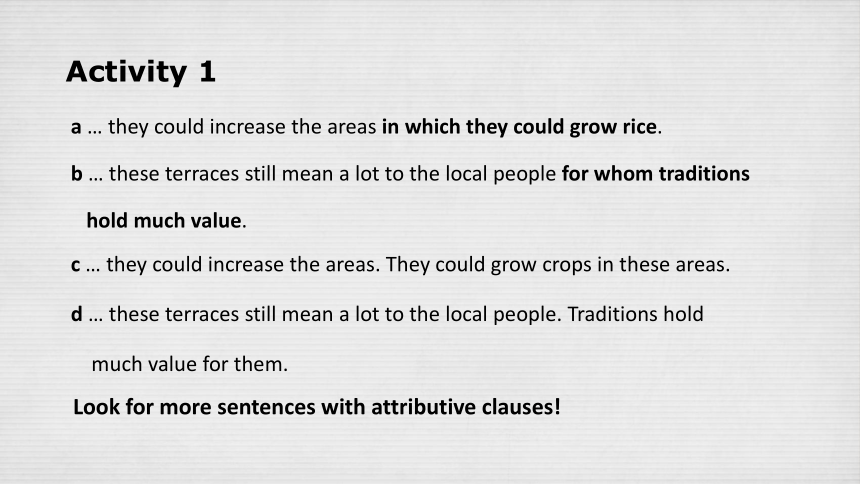
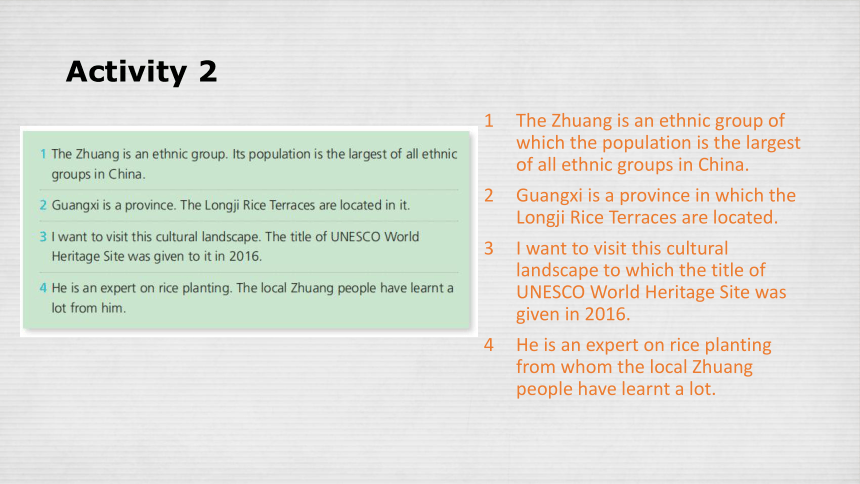
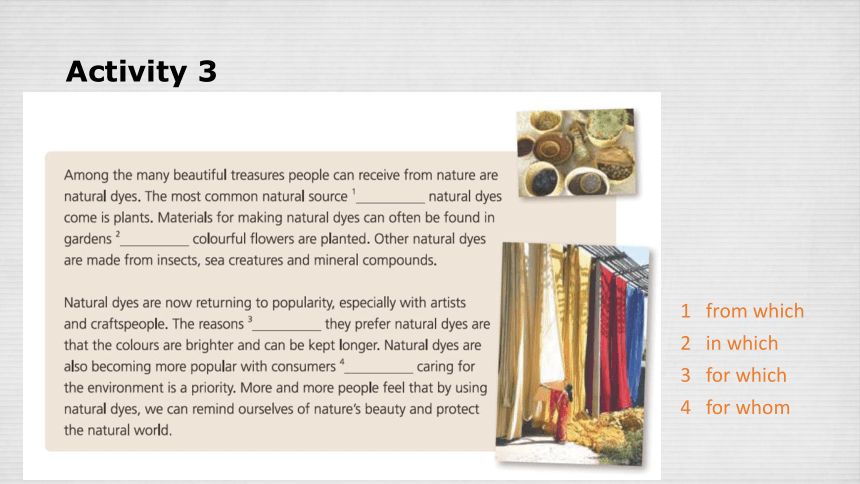


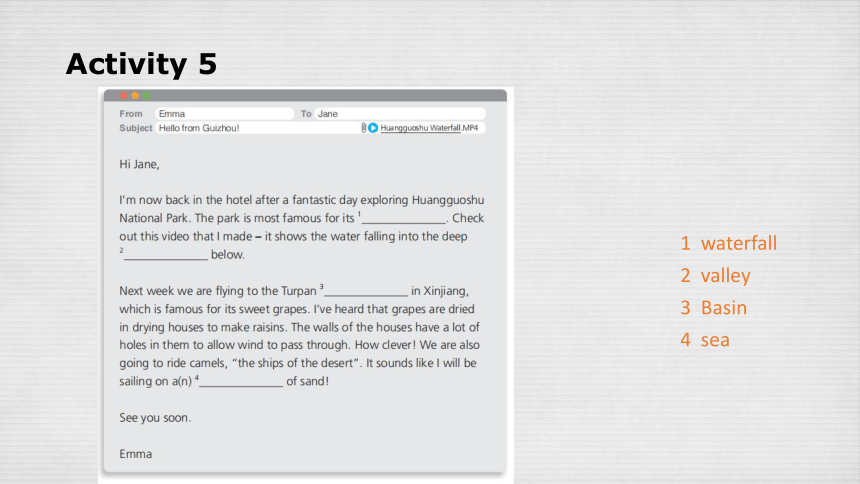
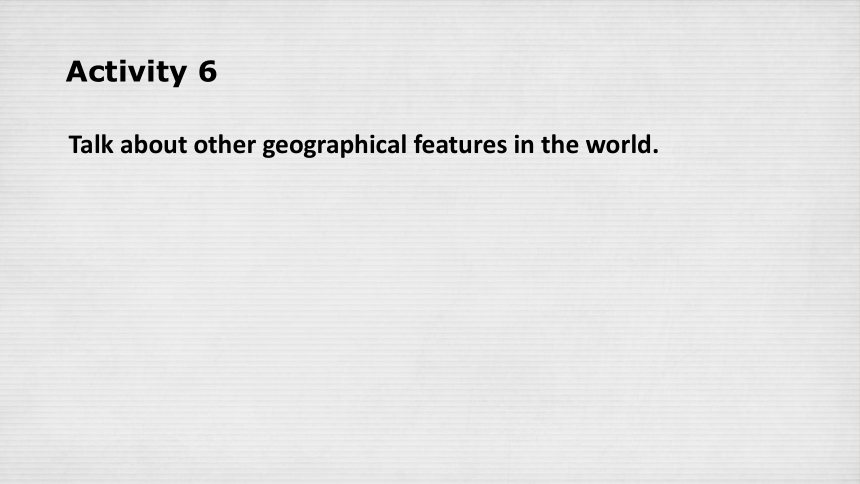
文档简介
(共28张PPT)
Unit 6 At one with nature
Using language
新标准《英语》高中必修第一册
Attributive clauses (3)
Activity 1
a … they could increase the areas in which they could grow rice.
b … these terraces still mean a lot to the local people for whom traditions
hold much value.
c … they could increase the areas. They could grow crops in these areas.
d … these terraces still mean a lot to the local people. Traditions hold
much value for them.
Look for more sentences with attributive clauses!
Activity 2
The Zhuang is an ethnic group of which the population is the largest of all ethnic groups in China.
Guangxi is a province in which the Longji Rice Terraces are located.
I want to visit this cultural landscape to which the title of UNESCO World Heritage Site was given in 2016.
He is an expert on rice planting from whom the local Zhuang people have learnt a lot.
Activity 3
1 from which
2 in which
3 for which
4 for whom
Geographical features
Activity 4
Located off the coast of Australia, the Great Barrier Reef is the biggest structure made by living organisms. You can explore the Great Barrier Reef by visiting an underwater observatory.
Part of the Colorado River Basin, the Grand Canyon is a valley that is almost two kilometres deep. Tourists can stand on a narrow glass platform called the Skywalk to see the Grand Canyon.
Victoria Falls is the largest waterfall in the world. The local people call it “the smoke that thunders”. The Victoria Falls Bridge connects the countries Zimbabwe and Zambia.
The English Channel separates England from France. These two countries are joined by the Channel Tunnel, a rail tunnel with a length of about 50 kilometres, most of which is under the sea.
a
b
c
d
Activity 5
1 waterfall
2 valley
3 Basin
4 sea
Activity 6
Talk about other geographical features in the world.
Life in different climate zones
Activity 7
c
d
b
a
e
b, d, e
Activity 8
1 building materials
2 be kept
3 fight the cold
4 cold weather
5 time
6 boring
7 job opportunities
8 polluted
Identify the language the girl uses to discuss advantages and disadvantages.
Activity 9
Work in pairs. Talk about life in the tropics and the Arctic.
Student A: Turn to Page 107.
Student B: Turn to Page 110.
Activity 10
Talk about the differences between life in southern China and northern China.
Understanding ideas
Activity 1
Talk about what you know about the Zhuang and Yao ethnic groups.
Activity 2
What problems did the local people meet
Why did these people go through so much trouble
How did the local people solve the problems by working with nature
Activity 3
To praise the wisdom of the ethnic groups living in Guangxi Zhuang Autonomous Region.
To explain how people worked in harmony with nature to create the Longji Rice Terraces.
To describe the beauty of the Longji Rice Terraces and to attract visitors to this scenic spot.
Author’s purpose
Activity 4
The Longji Rice Terraces were built by the local Zhuang ethnic group alone. Though there are many large, flat areas in the region, they built terraces on the mountains to have more areas to grow rice. The terraces are cleverly designed, and can wash away the shallow soil. There are hundreds of waterways, along which rainwater moves down the mountains and into the terraces. Today, local people use modern methods to maintain the terraces, and they attract lots of visitors from all over the country.
Correct four factual mistakes
Activity 4
The Longji Rice Terraces were built by the local Zhuang and Yao people. Since there are few large, flat areas of land in the region, they built terraces on the mountains to have more areas to grow rice. The terraces are cleverly designed, and can hold the shallow soil. There are hundreds of waterways, along which rainwater moves down the mountains and into the terraces. Today, local people use ancient methods of agriculture to maintain the terraces, and they attract lots of visitors from all over the country.
Activity 5
Retell the working principle
Think & Share
Why do the local people still keep their traditional way of growing rice
In what other ways do people live in harmony with nature Give examples.
Project
Investigate
Look at the “plant profile” and find out what information is included.
Explore your school campus to find out what different types of plants grow there.
Look for information about the plants your have found.
Plan
Get a notebook in which to put the “plant profiles”.
Choose the plants you want to include and make notes about each of them.
Create
Write your “plant profiles” in your notebook.
Add photos or sketches of the plants.
Present
Present your handbook to the class.
THANK YOU
Unit 6 At one with nature
Using language
新标准《英语》高中必修第一册
Attributive clauses (3)
Activity 1
a … they could increase the areas in which they could grow rice.
b … these terraces still mean a lot to the local people for whom traditions
hold much value.
c … they could increase the areas. They could grow crops in these areas.
d … these terraces still mean a lot to the local people. Traditions hold
much value for them.
Look for more sentences with attributive clauses!
Activity 2
The Zhuang is an ethnic group of which the population is the largest of all ethnic groups in China.
Guangxi is a province in which the Longji Rice Terraces are located.
I want to visit this cultural landscape to which the title of UNESCO World Heritage Site was given in 2016.
He is an expert on rice planting from whom the local Zhuang people have learnt a lot.
Activity 3
1 from which
2 in which
3 for which
4 for whom
Geographical features
Activity 4
Located off the coast of Australia, the Great Barrier Reef is the biggest structure made by living organisms. You can explore the Great Barrier Reef by visiting an underwater observatory.
Part of the Colorado River Basin, the Grand Canyon is a valley that is almost two kilometres deep. Tourists can stand on a narrow glass platform called the Skywalk to see the Grand Canyon.
Victoria Falls is the largest waterfall in the world. The local people call it “the smoke that thunders”. The Victoria Falls Bridge connects the countries Zimbabwe and Zambia.
The English Channel separates England from France. These two countries are joined by the Channel Tunnel, a rail tunnel with a length of about 50 kilometres, most of which is under the sea.
a
b
c
d
Activity 5
1 waterfall
2 valley
3 Basin
4 sea
Activity 6
Talk about other geographical features in the world.
Life in different climate zones
Activity 7
c
d
b
a
e
b, d, e
Activity 8
1 building materials
2 be kept
3 fight the cold
4 cold weather
5 time
6 boring
7 job opportunities
8 polluted
Identify the language the girl uses to discuss advantages and disadvantages.
Activity 9
Work in pairs. Talk about life in the tropics and the Arctic.
Student A: Turn to Page 107.
Student B: Turn to Page 110.
Activity 10
Talk about the differences between life in southern China and northern China.
Understanding ideas
Activity 1
Talk about what you know about the Zhuang and Yao ethnic groups.
Activity 2
What problems did the local people meet
Why did these people go through so much trouble
How did the local people solve the problems by working with nature
Activity 3
To praise the wisdom of the ethnic groups living in Guangxi Zhuang Autonomous Region.
To explain how people worked in harmony with nature to create the Longji Rice Terraces.
To describe the beauty of the Longji Rice Terraces and to attract visitors to this scenic spot.
Author’s purpose
Activity 4
The Longji Rice Terraces were built by the local Zhuang ethnic group alone. Though there are many large, flat areas in the region, they built terraces on the mountains to have more areas to grow rice. The terraces are cleverly designed, and can wash away the shallow soil. There are hundreds of waterways, along which rainwater moves down the mountains and into the terraces. Today, local people use modern methods to maintain the terraces, and they attract lots of visitors from all over the country.
Correct four factual mistakes
Activity 4
The Longji Rice Terraces were built by the local Zhuang and Yao people. Since there are few large, flat areas of land in the region, they built terraces on the mountains to have more areas to grow rice. The terraces are cleverly designed, and can hold the shallow soil. There are hundreds of waterways, along which rainwater moves down the mountains and into the terraces. Today, local people use ancient methods of agriculture to maintain the terraces, and they attract lots of visitors from all over the country.
Activity 5
Retell the working principle
Think & Share
Why do the local people still keep their traditional way of growing rice
In what other ways do people live in harmony with nature Give examples.
Project
Investigate
Look at the “plant profile” and find out what information is included.
Explore your school campus to find out what different types of plants grow there.
Look for information about the plants your have found.
Plan
Get a notebook in which to put the “plant profiles”.
Choose the plants you want to include and make notes about each of them.
Create
Write your “plant profiles” in your notebook.
Add photos or sketches of the plants.
Present
Present your handbook to the class.
THANK YOU
